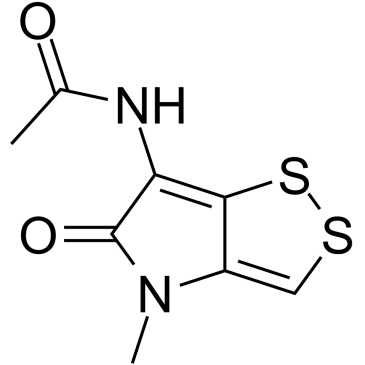硫藤黄素

硫藤黄素结构式

|
常用名 | 硫藤黄素 | 英文名 | Thiolutin |
|---|---|---|---|---|
| CAS号 | 87-11-6 | 分子量 | 228.291 | |
| 密度 | 1.6±0.1 g/cm3 | 沸点 | 478.6±45.0 °C at 760 mmHg | |
| 分子式 | C8H8N2O2S2 | 熔点 | 273-276℃ | |
| MSDS | 中文版 美版 | 闪点 | 243.3±28.7 °C | |
| 符号 |

GHS06 |
信号词 | Danger |
|
Condensin targets and reduces unwound DNA structures associated with transcription in mitotic chromosome condensation.
Nat. Commun. 6 , 7815, (2015) Chromosome condensation is a hallmark of mitosis in eukaryotes and is a prerequisite for faithful segregation of genetic material to daughter cells. Here we show that condensin, which is essential for assembling condensed chromosomes, helps to preclude the de... |
|
|
Thiophene-degrading Escherichia coli mutants possess sulfone oxidase activity and show altered resistance to sulfur-containing antibiotics.
Appl. Environ. Microbiol. 56(10) , 3179-85, (1990) We have previously isolated mutants of Escherichia coli which show increased oxidation of heterocyclic furan and thiophene substrates. We have now found that strains carrying the thdA mutation express a novel enzyme activity which oxidizes a variety of substr... |
|
|
Mapping of two transcription mutations (tlnI and tlnII) conferring thiolutin resistance, adjacent to dnaZ and rho in Escherichia coli.
Mol. Gen. Genet. 180(3) , 609-15, (1980) Two mutations in Escherichia coli conferring resistance to the transcription initiation inhibitor, thiolutin, have been mapped. One of these mutations (tln-I)( maps at 10.2 min on the genetic map and is cotransducible with dnaZ at a frequency of approximately... |
|
|
The transcriptional inhibitor thiolutin blocks mRNA degradation in yeast.
Yeast 25(2) , 85-92, (2008) Thiolutin is commonly used as a general inhibitor of transcription in yeast. It has been used to calculate mRNA decay rates by stopping the transcription and then determining the relative abundance of individual mRNAs at different times after inhibition. We r... |
|
|
Thiolutin-resistant mutants of Salmonella typhimurium.
Antimicrob. Agents Chemother. 22(4) , 541-7, (1982) Spontaneous mutants of Salmonella typhimurium isolated in our laboratory from thiolutin-containing tryptone agar plates are partially resistant to thiolutin in enriched media. In minimal media, they are not resistant. The mutants are not temperature sensitive... |
|
|
Effect of amino acids containing sulfur on dithiolopyrrolone antibiotic productions by Saccharothrix algeriensis NRRL B-24137.
J. Appl. Microbiol. 100(2) , 390-7, (2006) To study the effect of sulfur-containing amino acids (L-cysteine, L-cystine, L-methionine and DL-ethionine) on the production of dithiolopyrrolone antibiotics by Saccharothrix algeriensis NRRL B-24137.The production levels of dithiolopyrrolones were investiga... |
|
|
New dithiolopyrrolone antibiotics from Saccharothrix sp. SA 233. II. Physicochemical properties and structure elucidation.
J. Antibiot. 55(8) , 702-6, (2002) Three new natural dithiopyrrolone antibiotics, 3-methyl-2-butenoylpyrrothine (1), tigloylpyrrothine (2), and n-butyropyrrothine (3) were isolated along with the known isobutyropyrrothine (4) and thiolutin (5) from the fermentation broth of Saccharothrix sp. S... |
|
|
Lifetimes of mRNAs for clock-regulated proteins in a dinoflagellate.
Chronobiol. Int. 20(6) , 963-76, (2003) Both pulsed and continuous applications of the RNA polymerase II inhibitor thiolutin cause a dramatic but reversible loss of bioluminescence and its overt rhythmicity in cells of the dinoflagellate Lingulodinium polyedrum (formerly Gonyaulax polyedra). Such c... |
|
|
Thiolutin inhibits utilization of glucose and other carbon sources in cells of Escherichia coli.
Antonie van Leeuwenhoek 55(2) , 143-52, (1989) Thiolutin was found to inhibit the utilization of glucose and other growth substrates in Escherichia coli. The inhibition was detected by a sharp drop of the respiration rate after addition of the antibiotic. The actual function affected was allocated to the ... |
|
|
The yeast heat shock response is induced by conversion of cells to spheroplasts and by potent transcriptional inhibitors.
J. Bacteriol. 173(23) , 7429-35, (1991) We report here that procedures commonly used to measure transcription and mRNA decay rates in Saccharomyces cerevisiae induce the heat shock response. First, conversion of cells to spheroplasts with lyticase, a prerequisite for nuclear runoff transcription, i... |